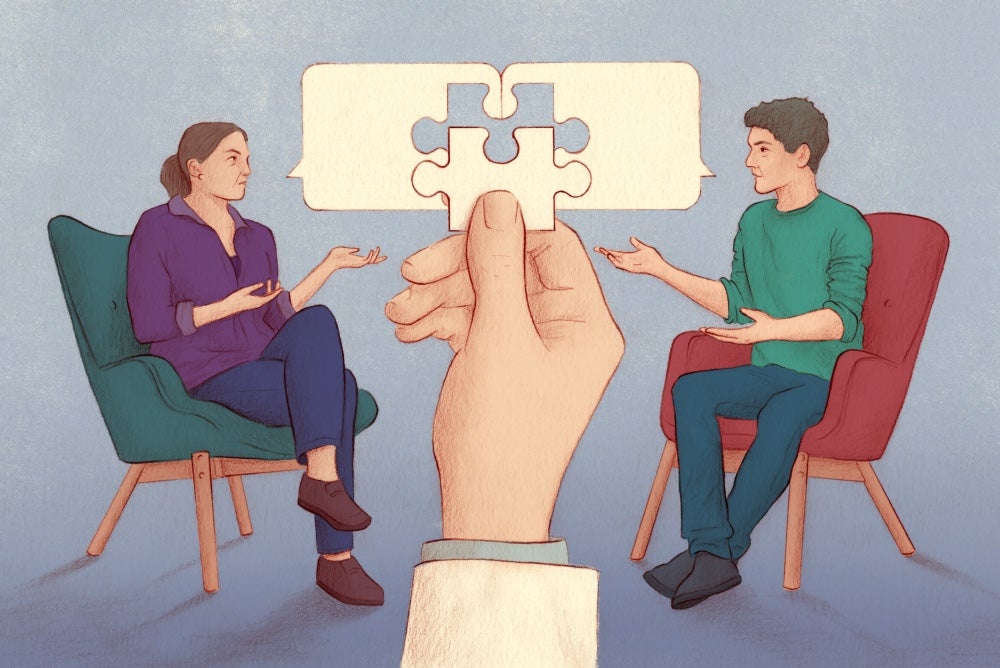
Clinical psychologist Craig Libman leans on “therapeutic neutrality” to help clients, medical providers, and families work through challenges—observing all viewpoints, and avoiding jumping to conclusions. Illustration by Elizabeth Sanduvete.
Can we, and should we, ever really be neutral? In a new series, Zócalo explores the idea of neutrality—in politics, sports, gender, journalism, international law, and more. In this essay, therapist Craig Libman explains how he helps families figure out a way forward when there are no good options.
“He just doesn’t listen to me!” “She never understands what I’m going through!”
There I sat, their psychotherapist, sandwiched between this couple who had been married at least 50 years. The husband, a Vietnam veteran with metastatic cancer, longstanding PTSD, and increased impairments from dementia. The wife, a full-time caregiver and retired school administrator, stressed out and facing her own increased cognitive challenges. This marriage, woven together by three children, many grandchildren, five military deployments, countless life celebrations and family funerals. Their love language: arguing.
Of course, they didn’t call it fighting—they saw their “discussions” as spirited debates. Seeing their faces brighten when they talked over each other almost felt like eavesdropping on covert foreplay. They vaguely reminded me of my own grandparents, except now I couldn’t sit back and watch bemusedly from the roomy backseat of Poppy’s Lincoln.
As their therapist, I had to engage, mediate, and navigate their needs. I had to assert therapeutic neutrality, balancing both parties’ perspectives while also managing my own viewpoints and biases.
“Neutral” conjures a sense of complete objectivity, impartial and dispassionate, that rarely exists in realistic realms of human experience. When I work with couples or families, instead of completely removing myself from the conflict, I focus on how to acknowledge, validate, and work with all perspectives in the room, even if some disagreements can never be fully resolved.
It doesn’t always come easily. When I trained in geriatrics, I had little coursework in family and couples therapy and no idea what working with families would be like. Referrals typically called for individual therapy, but patients often wanted loved ones in the room—or, in the presence of dementia, needed them there.
Complex dynamics led family members to try to curry favor with me, seeking validation that they were the “correct” party. Boundary setting became even more crucial. Who was my primary patient? Did they even want family therapy? I work in a medical system designed for veterans, which typically favors their needs, even with built-in caregiver supports. How do I ensure I’m addressing the needs of spouses or other family caregivers, while also staying true to the veteran patient?
Literature on “therapeutic neutrality” is sparse, but reading what’s out there offered me a helpful framework to start from. I was particularly drawn toward psychologists Charles Gelso and Katri Kanninen’s definition. They posit that effective therapeutic neutrality occurs when the therapist “takes an observer position in the relationship…refrains from taking sides in the patient’s inner struggles…[and] does not take sides in the patient’s relational struggles.”
One of the major challenges of any kind of therapy with multiple people is that it challenges therapeutic rapport: If I align with one person, I run the risk of pushing against another. Family therapists Mark Butler and colleagues offer a solution: maintaining a stance of dynamic neutrality, in which the “therapist invites and facilitates each person in gaining an empathic window on others’ experience and perspective and then holding their partner’s experience equally valid with their own and equally significant to relationship success.”
In my work with families and couples navigating complex medical issues, I had, without fully realizing it, already been employing this technique, taking extra time to observe all viewpoints and not jump to conclusions.
This is especially essential when I am a part of family meetings among patients, family, and medical providers in the hospital. Once, I found myself and three doctors jammed into every crevice of a small hospital room, hashing things out with a patient and two of his sisters. Nobody was happy. Not the patient, who was frustrated by a prolonged hospital stay and wanted to relocate to one of his sisters’ houses. Not his sisters, who wanted to move him to an assisted living facility. Not the medical and psychiatric teams, who wanted to send him to a skilled nursing facility for rehab and likely longer-term care, whether he wanted it or not.
They debated what should happen next. The patient couldn’t stay in the hospital indefinitely, for medical and financial reasons. But he also still needed a lot of help managing his pain and completing personal care such as toileting, bathing, and dressing. Everyone in the room was frustrated and overwhelmed.
I sat and listened, and tried to balance the complex facts with each party’s opinions, feelings, and needs. Everyone wanted a solution—their solution—so badly, that no one, least of all the patient himself, was heard and respected. Rather than offering solutions, I mediated, trying to create time and space for each person to talk. We did not come up with an answer, but we made progress in listening.
The conclusion the group reached several days later—trying out a skilled nursing rehab location close to the patient’s home and family, with eventual plans to transfer home—wasn’t perfect, but the meeting reset the conversation to a place of greater equity and inclusivity.
Neutrality helped me balance the needs and limitations of a difficult reality. In a space of narrow choices, this one was best aligned with the care the patient wanted.
With the Vietnam vet and his wife, this notion of neutrality as observation helped me reconnect the couple with the things that brought them together in the first place. Rather than leaning into their disagreements and arriving at judgments about who was right, we took trips down Memory Lane. We discussed how they met in college, set up by friends, and how they have been arguing for decades. They talked about what they admired and found attractive about each other. They remembered their accomplishments, their goals, and their mutual commitment.
I don’t approach therapeutic neutrality with a cold, dispassionate lens. Instead, I try to find ways to use curiosity, exploration, and observations of points of connection to help couples, families, and medical teams work through conflict. Rather than focusing on how someone wants another person to change, I use prompts to help people rediscover what they value, and how the people around them bring them closer to it. I’ve learned that my job, as a neutral therapist, is to help patients and their loved ones strengthen their bonds.








Send A Letter To the Editors